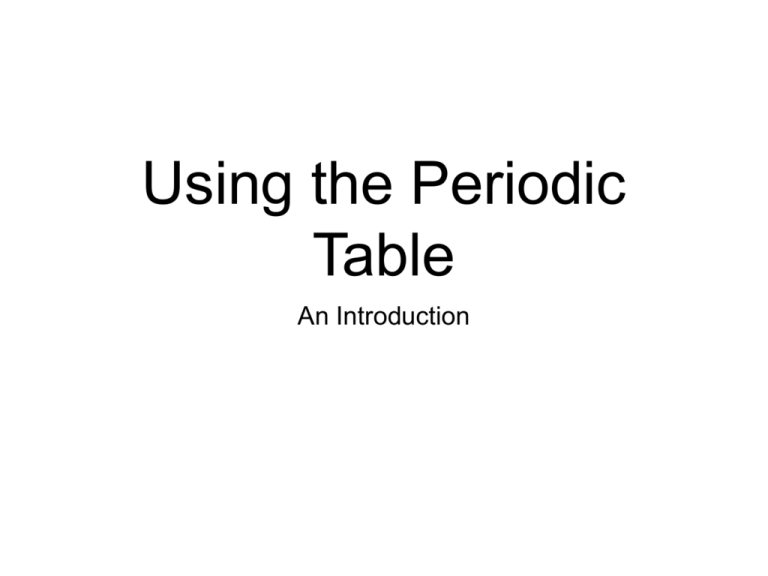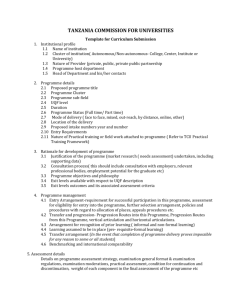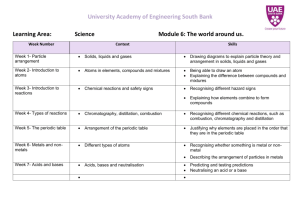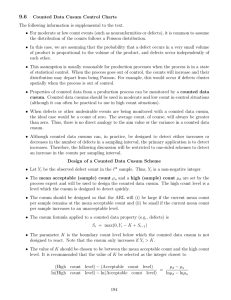Using the Periodic Table
advertisement

Using the Periodic Table An Introduction What is the Periodic Table? • • • It is a list of elements. The arrangement of the elements is a guide to the chemistry of those elements. It is also a guide to the properties of those elements. The Arrangement of the Table • The Table has vertical columns called “groups” or “families.” The Arrangement of the Table • The Table has vertical columns called “groups” or “families.” The Arrangement of the Table • The Table has vertical columns called “groups” or “families.” Alkali metal group The Arrangement of the Table • The Table has vertical columns called “groups” or “families.” Alkaline earth group The Arrangement of the Table • The Table has vertical columns called “groups” or “families.” Halogen group The Arrangement of the Table • The Table has vertical columns called “groups” or “families.” Noble gas group The Arrangement of the Table • The Table has vertical columns called “groups” or “families.” Each of these groups has its own particular chemistry. The Arrangement of the Table • The Table has vertical columns called “groups” or “families.” Alkali metals form ions with a single positive charge. The Arrangement of the Table • The Table has vertical columns called “groups” or “families.” Each alkaline earth metal forms ions with two positive charges. The Arrangement of the Table • The Table has vertical columns called “groups” or “families.” Each halogen forms ions with a single negative charge. The Arrangement of the Table • The Table has vertical columns called “groups” or “families.” Each noble gas is unreactive. The Arrangement of the Table The Arrangement of the Table • The Table has horizontal rows called “periods.” The Arrangement of the Table • The Table has horizontal rows called “periods.” First period The Arrangement of the Table • The Table has horizontal rows called “periods.” Second period The Arrangement of the Table • The Table has horizontal rows called “periods.” Third period The Arrangement of the Table • The Table has horizontal rows called “periods.” Fourth period The Arrangement of the Table • The Table has horizontal rows called “periods.” Fifth period The Arrangement of the Table • The Table has horizontal rows called “periods.” Sixth period The Arrangement of the Table • The Table has horizontal rows called “periods.” Seventh period The Arrangement of the Table • The Table has horizontal rows called “periods.” The Arrangement of the Table • The Table has horizontal rows called “periods.” We see a gradual change in the properties and reactivities as we move across a period. We will explore this more in Unit 1b. The Arrangement of the Table The Arrangement of the Table • The table is also divided by the type of element. The Arrangement of the Table • The table is also divided by the type of element. There are metals. The Arrangement of the Table • The table is also divided by the type of element. There are metals. There are nonmetals. The Arrangement of the Table • The table is also divided by the type of element. There are metals. There are nonmetals. There are metalloids. The Arrangement of the Table • The table is also divided by the type of element. The Arrangement of the Table Each space in the table represents an element. • Which looks like this: Each space in the table represents an element. • Which looks like this: 6 C Carbon 12.011 [He] 2s22p2 Each space in the table represents an element. • Which looks like this: 6 C Carbon 12.011 [He] 2s22p2 Each symbol in the space gives information about the element. Each space in the table represents an element. • Which looks like this: 6 C Carbon 12.011 [He] 2s22p2 Atomic number is the number of protons in the nucleus of the atom. Each space in the table represents an element. • Which looks like this: 6 C Carbon 12.011 [He] 2s22p2 The symbol is an abbreviation of the name of the element Each space in the table represents an element. • Which looks like this: 6 C Carbon 12.011 [He] 2s22p2 The name of the element Each space in the table represents an element. • Which looks like this: 6 C Carbon 12.011 [He] 2s22p2 The average atomic mass of the element in nature Each space in the table represents an element. • Which looks like this: 6 C Carbon 12.011 [He] 2s22p2 The electron configuration of the element in a neutral state Each space in the table represents an element. • Which looks like this: However, elements with no stable state will have spaces that look like this. Each space in the table represents an element. • Which looks like this: 43 Tc Technitium (97.9072) [Kr] 4d65s1 However, elements with no stable state will have spaces that look like this. Each space in the table represents an element. • Which looks like this: 43 Tc Technitium (97.9072) [Kr] 4d65s1 The atomic mass of the most stable or most common isotope of the element in nature Each space in the table represents an element. • Which looks like this: 43 Tc Technitium (97.9072) [Kr] 4d65s1 Summary • • • • Organized by columns (groups) Organized by rows (periods) Organized by type of element (metal, nonmetal, or metalloid) Each space gives information about each element (atomic number, symbol, name, atomic mass, and electron configuration)



